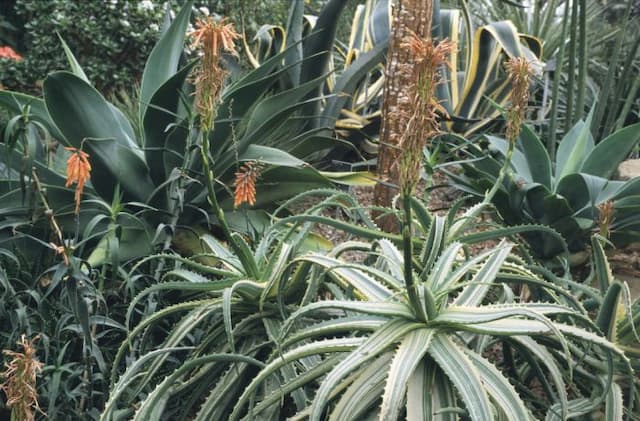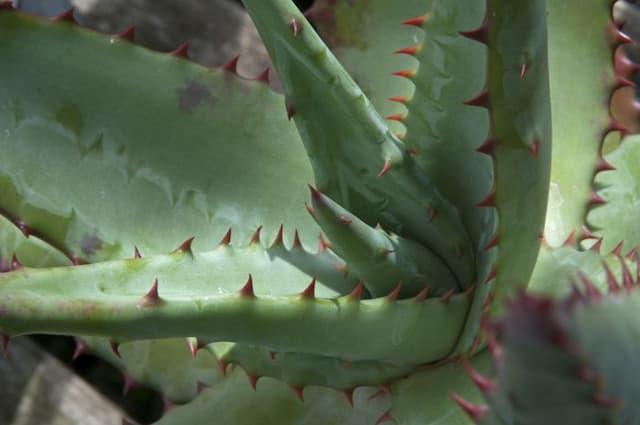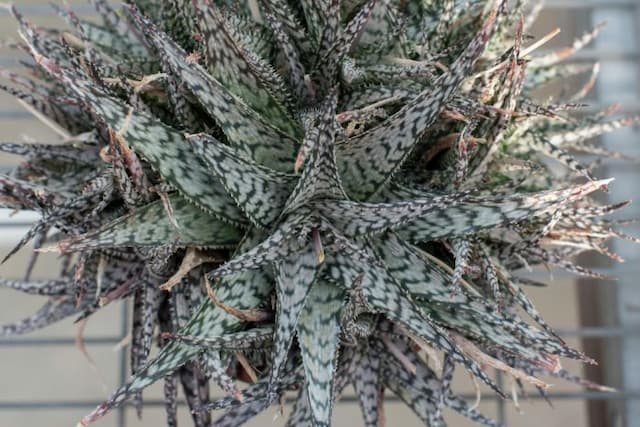Red Hot Poker Kniphofia 'Tawny King'

ABOUT
Kniphofia 'Tawny King,' commonly known as Red Hot Poker, is a striking perennial plant recognized for its distinctive flower spikes. The blooms are a harmonious gradient of color, with warm shades ranging from cream at the top through a gentle amber, descending into rich bronze and tawny hues at the bottom of the elongated cluster. These flame-inspired flowers emanate a tropical vibrancy and are borne aloft on strong, upright stems that rise from a robust base. The foliage of the Red Hot Poker consists of clumps of slender, grass-like leaves that create a textured, lush green backdrop to the vibrant spires of the flower display. These leaves may curve gracefully, lending an elegant appearance to the plant's base. The plant itself exudes an exotic aura, often becoming a focal point in gardens due to its bold, torch-like flower spikes that seem to glow when backlit by the sun. Overall, the Red Hot Poker is recognized for this characteristic floral presentation, which is not only visually arresting but also attractive to a variety of pollinators such as hummingbirds and bees. The presence of these flowers adds a dynamic vertical element to landscapes and gardens, often contributing to a vibrant and diverse planting scheme.
About this plant
 Names
NamesFamily
Asphodelaceae
Synonyms
Red Hot Poker, Torch Lily, Poker Plant
Common names
Kniphofia 'Tawny King'.
 Toxicity
ToxicityTo humans
The Red Hot Poker (Kniphofia 'Tawny King') is not commonly listed as a toxic plant to humans. However, it is always advisable to handle plants with care and to avoid ingesting any plant parts if you are not certain of their edibility or potential toxicity. If accidental ingestion occurs, watch for any adverse reactions and consult a medical professional for guidance.
To pets
The Red Hot Poker plant is not typically considered toxic to pets. However, caution should be exercised as individual animals can have varying sensitivities to plants. Ingesting plant material might cause mild gastrointestinal upset, so it is always best to prevent pets from eating ornamental plants. If you suspect your pet has ingested parts of the plant and is showing signs of distress, consult with a veterinarian.
 Characteristics
CharacteristicsLife cycle
Perennials
Foliage type
Evergreen
Color of leaves
Green
Flower color
Mixed
Height
3-4 feet (0.9-1.2 meters)
Spread
2-3 feet (0.6-0.9 meters)
Plant type
Herb
Hardiness zones
5-9
Native area
South Africa
Benefits
 General Benefits
General Benefits- Attracts Pollinators: Kniphofia 'Tawny King', commonly known as Red Hot Poker, is known for attracting bees, butterflies, and other beneficial pollinators to the garden.
- Drought Tolerant: Once established, this plant is quite tolerant of drought, making it a good choice for water-wise gardens.
- Architectural Interest: With its tall, striking flower spikes and lush foliage, Red Hot Poker adds vertical interest and an architectural element to garden designs.
- Easy to Grow: This plant is generally easy to care for and can thrive in a variety of soil types, as long as there is good drainage.
- Deer Resistant: Red Hot Poker is typically resistant to deer, which makes it a good choice for gardens in areas with a large deer population.
- Seasonal Color: It offers vibrant blooms that add a pop of color to the garden from late spring to summer, with its unique red-orange to yellow flowers.
- Low Maintenance: Kniphofia 'Tawny King' requires minimal maintenance once established, making it suitable for gardeners of all skill levels.
 Medical Properties
Medical PropertiesThis plant is not used for medical purposes.
 Air-purifying Qualities
Air-purifying QualitiesThis plant is not specifically known for air purifying qualities.
 Other Uses
Other Uses- As a natural dye: The flowers of the Red Hot Poker plant may be used to produce a natural dye for fabrics, yarn, or paper, offering a range of warm hues.
- In crafting and flower arrangements: Dried flower stalks can be used in floral crafts or as a part of dry flower arrangements for their interesting form and color.
- Insect habitat: Red Hot Poker can provide a habitat for beneficial insects when allowed to grow in a dense clump, offering shelter amidst its foliage.
- Erosion control: Its root system can help reduce soil erosion on sloped gardens by anchoring the soil effectively.
- Garden sculpture: When planted in mass or as a focal point, the vertical flower spikes can create a sculptural effect in garden design.
- Photography: The striking appearance of the Red Hot Poker makes it an excellent subject for botanical and garden photography.
- Bioindicator: Changes in the plant's health and flowering patterns could potentially indicate changes in environmental conditions like soil quality or air moisture levels.
- Companion planting: It can be used alongside other plants that have similar water and sun requirements to create a cohesively water-wise garden area.
- Thermal mass in passive solar greenhouse design: The dense foliage can collect and hold heat during the day, reducing temperature fluctuations in a passive solar greenhouse.
- Nectar source for home-made syrups: While unconventional, the nectar from the Red Hot Poker flowers can be used to make homemade floral syrups for use in unique culinary concoctions.
Interesting Facts
 Feng Shui
Feng ShuiThe Red Hot Poker is not used in Feng Shui practice.
 Zodiac Sign Compitability
Zodiac Sign CompitabilityThe Red Hot Poker is not used in astrology practice.
 Plant Symbolism
Plant Symbolism- Standout Appearance: Kniphofia, commonly known as Red Hot Poker, with its bold and striking flower spikes, symbolizes visual impact and attraction. The 'Tawny King' variety, in particular, can represent majesty and worthiness due to its regal-sounding name and notable presence in a garden setting.
- Resilience: Red Hot Pokers are known for being hardy and able to withstand tough conditions. As such, they often symbolize strength, resilience, and the ability to endure challenging circumstances.
- Flamboyance: With their vibrant, fiery blooms, these plants can represent flamboyance and a fiery personality, appealing to those who wish to make a bold statement.
- Attention and Focus: Due to the plant's height and bright flowers that reach towards the sky, it can symbolize drawing attention or pointing towards an important aspect, much like a lighthouse or beacon.
- Warmth and Energy: The warm-toned flowers convey warmth, energy, and enthusiasm, resembling the flames of a fire and promoting a sense of vibrancy in the garden or as a symbolic gesture.
 Water
WaterRed Hot Poker plants require consistent moisture, especially during their blooming period. Water the plant deeply once a week, providing about 1 inch of water each time, which roughly equals 0.5 gallons for a small garden area. It is important to adjust watering based on rainfall and be cautious not to overwater, as excessive moisture can lead to root rot. During hot and dry spells, increase watering frequency to prevent the soil from drying out completely. Reduce watering in the fall as the plant prepares for dormancy.
 Light
LightRed Hot Poker plants thrive in full sunlight conditions. They need a minimum of 6 hours of direct sunlight each day to perform best. Choose a spot in your garden that receives unobstructed sunlight throughout the day. Partial shade is tolerable, especially in extremely hot climates, but full sun is ideal for the healthiest growth and best flowering.
 Temperature
TemperatureRed Hot Poker plants are adaptable to a range of temperatures and can survive in minimum winter temperatures of 20 degrees Fahrenheit. They prefer warmer climates and perform best when daytime temperatures are between 50 to 90 degrees Fahrenheit. Extreme cold or frost can damage the plant, so provide protection or consider container planting in regions with harsh winters.
 Pruning
PruningPruning Red Hot Poker plants helps to maintain their appearance and encourage more blooms. After flowering, cut back the flower stalks to the base to stimulate new growth. In late winter or early spring, prune dead or damaged foliage to tidy the plant and prepare for new growth. Pruning should be done annually or as needed to remove spent blooms and improve plant vigor.
 Cleaning
CleaningAs needed
 Soil
SoilRed Hot Poker, prefers well-drained soil with a mix of sand, loam, and compost; ideal soil pH is 6.0 to 6.5.
 Repotting
RepottingRed Hot Poker rarely needs repotting; it's a perennial best left undisturbed once planted.
 Humidity & Misting
Humidity & MistingRed Hot Poker tolerates a wide range of humidity levels and does not require high humidity.
 Suitable locations
Suitable locationsIndoor
Place Red Hot Poker near a sunny window and ensure good airflow.
Outdoor
Plant Red Hot Poker in full sun with well-draining soil.
Hardiness zone
5-9 USDA
 Life cycle
Life cycleThe 'Tawny King' Kniphofia, commonly known as Red Hot Poker, begins its life cycle with seed germination, occurring in warm, moist soil. Following germination, seedlings emerge and develop into juvenile plants with a rosette of narrow, strap-like leaves. As the plants mature, they form a strong, rhizomatous root system, enabling them to survive periods of drought and cold. The mature Red Hot Poker produces tall, sturdy flower spikes topped with tubular flowers that transition from cream to rich orange or tawny tones, attracting pollinators like bees and hummingbirds during the blooming season in late spring to summer. After pollination, seeds are formed and dispersed, completing the reproductive cycle. Kniphofia 'Tawny King' then enters a period of dormancy in winter, conserving energy to repeat the cycle in the following growing season.
 Propogation
PropogationPropogation time
Spring to Summer
Kniphofia 'Tawny King', commonly known as Red Hot Poker, is typically propagated by division, which is the most popular method. The ideal time to divide Red Hot Poker plants is in late spring, after they have finished flowering, or in early fall. To propagate through division, the clumps should be carefully lifted from the ground using a garden fork, ensuring minimal damage to the root system. Once lifted, the clump should be divided into smaller sections, each with at least one growing point. These divisions can then be replanted at the same depth they were growing previously, spaced about 18 inches (approximately 45.7 centimeters) apart to allow adequate space for growth. Following replanting, the new divisions should be watered thoroughly to help establish them in their new location. This method allows gardeners to create new plants that are true to the parent plant in form and color.









